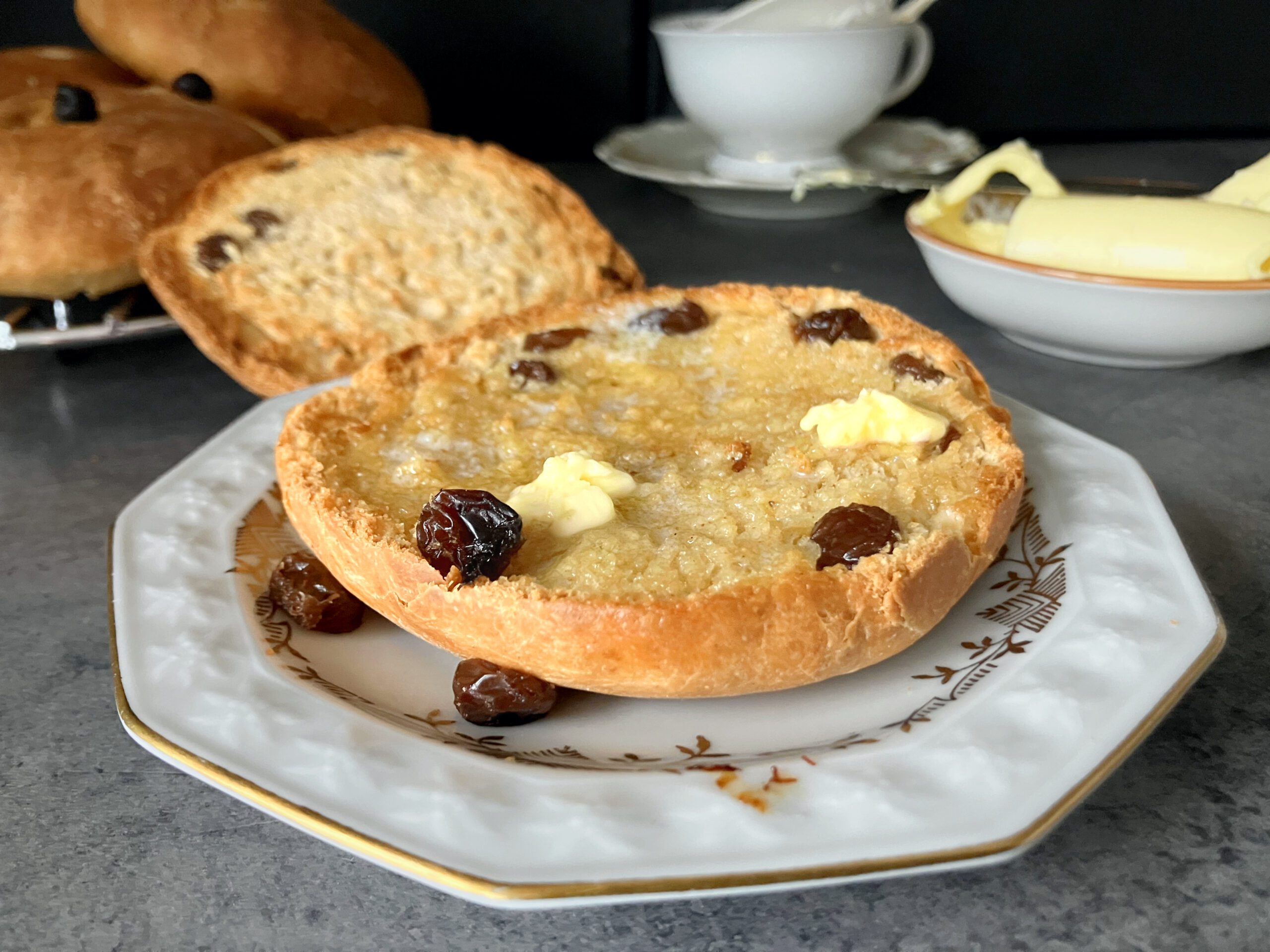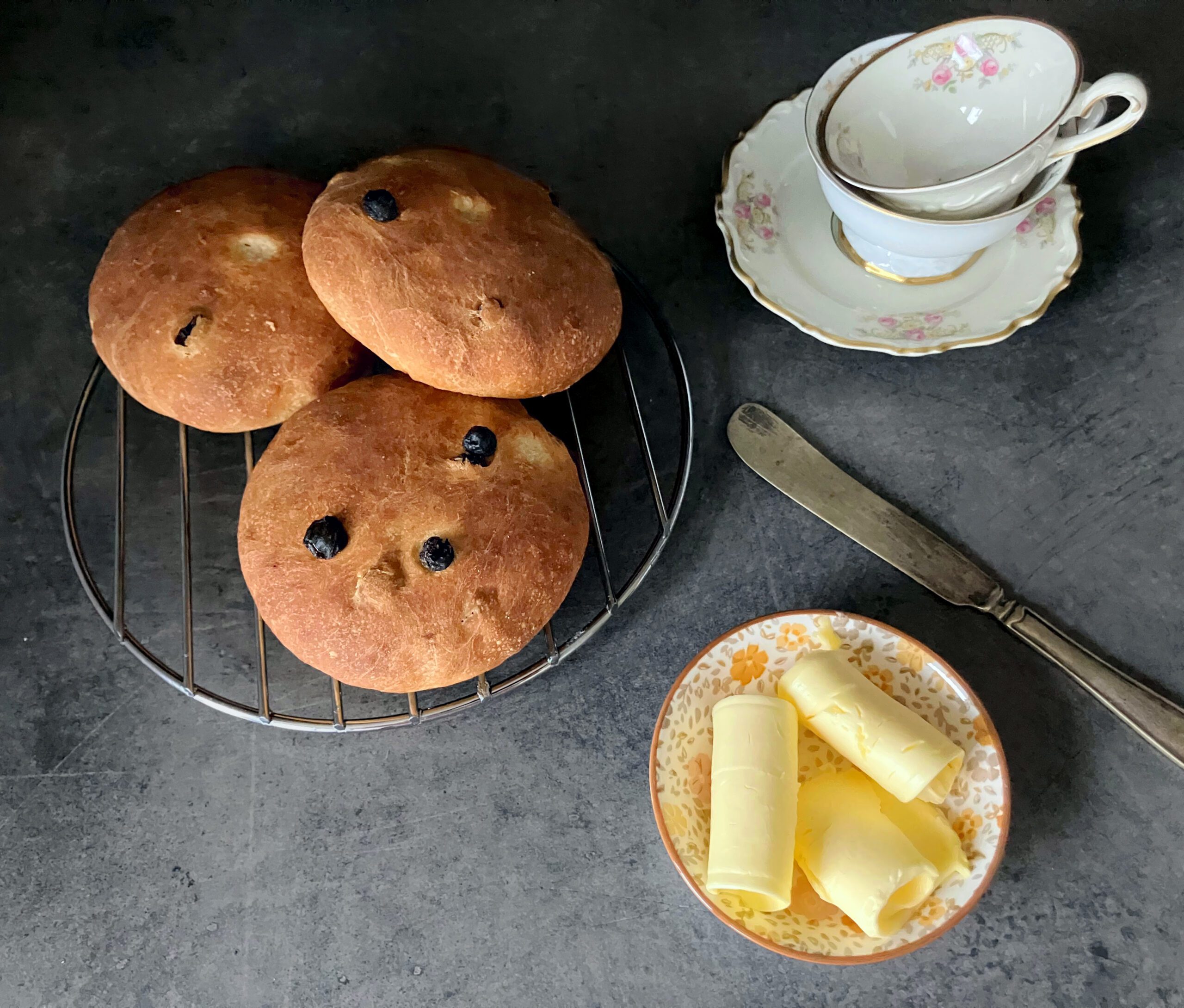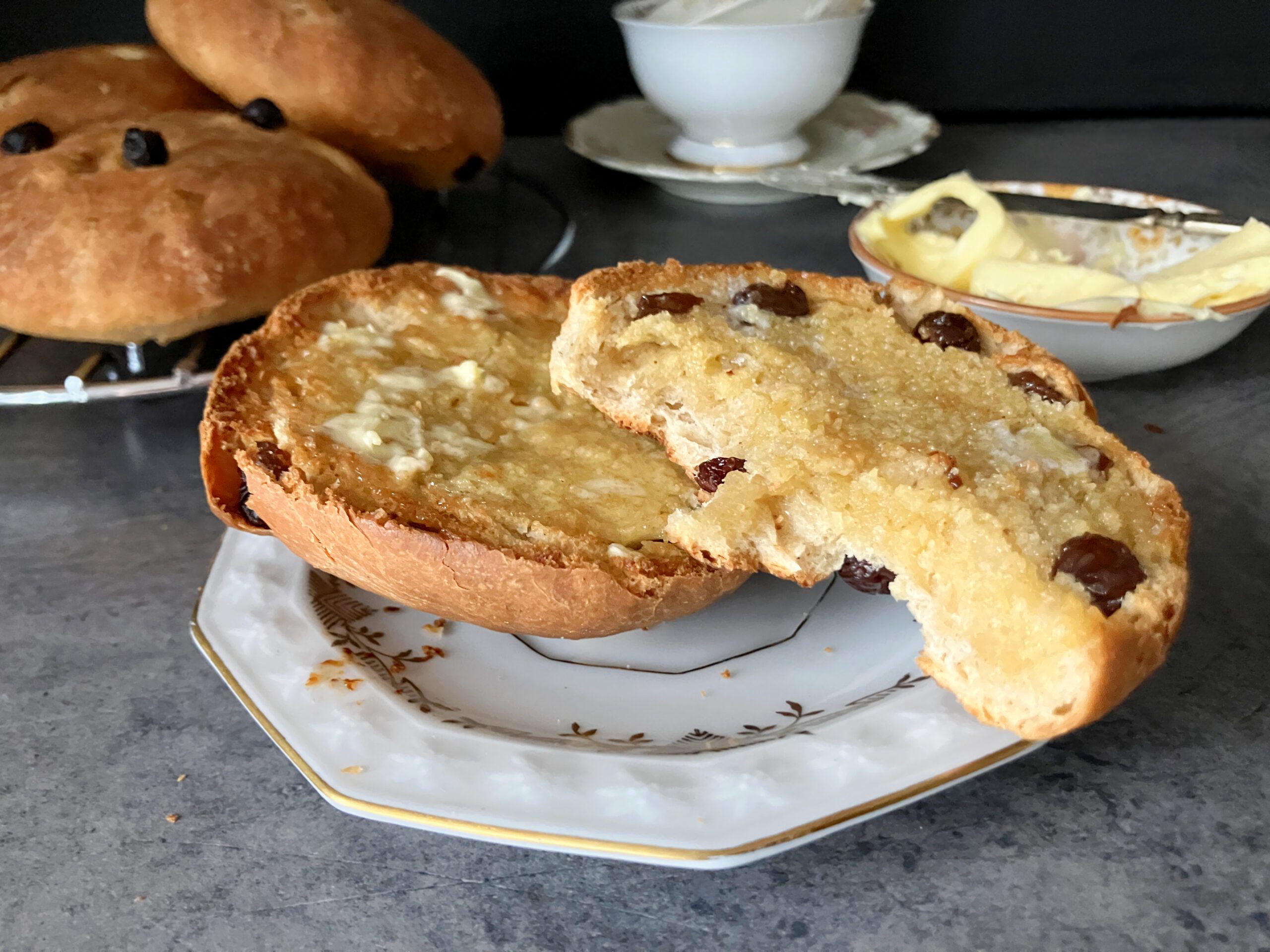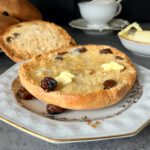Spelt English Teacakes
“I am just now starting to use spelt again after years without. Should have stayed with it. Anyway, love your site. So many different recipes to try. My hubby is missing wheat but can have spelt so I want to make things that are different & he will enjoy.”
★★★★★
Spelt English teacakes are a traditional yeasted bread bun, delicately spiced, and peppered with dried fruit. They are whipped up in no time, and are best served toasted with lashings of butter. The recipe can be adapted to use all-purpose (plain) flour.
If you’re new to spelt flour and still finding your feet, check out my tutorial: A Beginner’s Guide to Spelt Flour.
Some of the links in this post might be affiliate links. Please read my disclosure and privacy policy for more information.
_________
|
|
| What are teacakes |
| How are teacakes eaten? |
| Teacakes around the world |
| Teacake variations and adaptations |
| More sweet spelt bread recipes |
Baking traditional food from the UK is often tricky. We have a very long history of creating some wonderful baked treats, and our food (and the names we’ve given it) is heavily influenced by our previous guests, such as the Normans and other northern European settlers.
The terms for food also vary enormously, depending on where people live. Think of the humble portion-sized bread. I call it a bun or roll, but did you know that in the UK, there are at least six other ways to say it? More confusingly, in Manchester, they call it a teacake.
What are teacakes?
Well, that depends on who you are asking. As mentioned, Mancunians are referring to a plain bread bun. And in other countries? Well, a teacake is often something else entirely.
English teacakes are slightly sweetened, lightly spiced yeast bread peppered with sultanas or raisins, that are flattened flat before baking. In addition, they sometimes contain fruit peel. My mum often made me toasted teacakes, and I loved them, but I wasn’t keen on the peel (which I used to pick out). Like many of our traditional recipes, the history of English teacakes is a little hazy, but they are thought to originate from the north of England.
Sometimes, these fruit teacakes are referred to as Yorkshire teacakes. I’ve done some research and see very little difference between the two, although the latter seem to be a little bigger. My family has lived in the sleepy market town of Barnard Castle for generations, which used to be under the jurisdiction of North Yorkshire (but is now County Durham), and I always remember teacakes as being rather large.
How are teacakes eaten?
I have to be honest and say that I have never eaten a teacake any other way than toasted. It appears that in bygone years, English teacakes were enjoyed straight from the oven, but these days, the are most often popped into the toaster. This is similar to other lightly sweetened and spiced bread, such as hot cross buns.
Teacakes need nothing more than a good layer of creamy butter, but many like to add marmalade or jam. Despite the name, a cup of tea to accompany them is not mandatory.
Teacakes around the world
In Sweden, a tekaka (tea cake) looks fairly similar, and is also a butter enriched yeasted bread, sweetened with light syrup. Although it is quite flat like an English teacakes, there are no spices or dried fruit, and it is used as a filling for savoury items such as ham and cheese.
However, in Scotland, teacakes are something completely different. Tunnocks teacakes are a national institution and aren’t remotely bread-like. Instead, they are marshmallow dolloped onto shortbread biscuits (cookies) and smothered in milk or dark chocolate. Goodness, it’s a long time since I had one, and now I have somewhat of a hankering for one.
In the USA, a tea cake is a thick cookie with a cake-like consistency. Made with sugar and flavoured with spices, they have a history spanning nearly 200 years. An Australian teacake is actually a plain sponge cake, often finished off with a cinnamon topping.
Teacake variations and adaptations
Teacakes are a good example of how not only names, but also recipes, can vary enormously due to geographical location. Some recipes include an egg, others omit the spice. For my recipe, I’ve not included any peel (as mentioned above, I don’t like it). However, next time I make a batch, I might include some of my candied clementine peel, as I think that would be delicious.
Many traditional recipes include mixed spice, which is a lovely combo of cinnamon, ginger, coriander, cloves and nutmeg. Although part of the teacakes’ deliciousness is the slight hit of spice, it isn’t supposed to be overpowering, and it is added in moderation. I didn’t have any jarred mixed spice. I thought about making my own, but I was missing the cloves and mace, so went with just adding a teaspoon of cinnamon along with a sprinkling of ginger, nutmeg and coriander. It worked beautifully.
Teacakes can vary in size, thickness and texture. The teacakes of my childhood were flat and quite dense, and this was what I was trying to recreate with this recipe. If you prefer a fluffier bun, don’t flatten them down before baking.
Of course, I went with white spelt flour, which worked amazingly well. You can easily adapt the recipe to use all-purpose (plain) or even bread flour. Naturally, the texture is a slightly different when using spelt, but it isn’t anything you would care about (or even notice).
Chocolate-filled overnight buns (with chocolate icing)
Spelt English Teacakes
Ingredients
- 150ml (½ cup + 2 tbsp) milk
- 35g butter (softened)
- 240g (2 cups) spelt (see note 1)
- 1 tbsp sugar
- ¾ tsp cinnamon
- ⅛ tsp ginger
- sprinkle coriander
- sprinkle nutmeg
- 7g (2¼ tsp) yeast (see note 2)
- 75g (½ cup) sultanas or raisins
Instructions
- Heat the milk, just until it is lukewarm (I give it a quick burst in the microwave).
- Pour into a standmixer (or bowl).
- Add the other ingredients, apart from the dried fruit.
- Using a dough hook, set your stand mixer going. If you are not using a stand mixer, knead the dough on a floured surface for about five minutes and skip to instruction number seven.
- Need for around two minutes, then add in the sultanas.
- Knead again for around five minutes. The dough will be slightly tacky, but will easily drop off the hook when you pull it gently.
- Give the dough a couple of kneads by hand, just to make sure the sultanas are evenly distributed.
- Cover the bowl with clingfilm and leave in a warm place to proof for around an hour (or until the dough as double in size).
- Pre-heat the oven to 190℃ (375℉).
- Pour the dough out onto a lightly floured surface, and divide the dough into four pieces weighing around 130g (4½ oz) each.
- Roll each piece until it is nice and round and then place on a baking tray.
- Using your fingers, press down to flatten each ball (make sure you leave plenty of space between them).
- Cover with a tea-towel, and leave to rest for 30 minutes.
- Brush with a little milk and bake for around 12-14 minutes, until the tops are a deep brown. Keep an eye on them, as you don't want them to burn.
- Remove from the oven and allow to cool completely. Then, cut one in half, pop it in the toaster, and slather with butter (see note 3).
Notes
- You can use all-purpose or even bread flour in place of the spelt. Just use the same measurements as specified.
- In Sweden we have something called dried yeast. It is used both in warm liquid to proof and also added directly to flour. I am aware that the US has two options for dried yeast, and I believe instant yeast is the most similar for the purpose of making this particular bread.
- As with most spelt bread, the freshness of the teacakes quickly deteriorates. If you are planning on toasting them, they will sit on the counter top for a couple of days without any problems, but any longer (or if you want to eat them un-toasted), I would always recommend leftovers to be frozen.
2 thoughts on “Spelt English Teacakes”
Leave a Reply









I am just now starting to use spelt again after years without. Should have stayed with it. Anyway, love your site. So many different recipes to try. My hubby is missing wheat but can have spelt so I want to make things that are different & he will enjoy.
Thank you so much for your kind comments, Ruth! I also find that spelt is so much easier on my stomach, and I am continually amazed at how easy it is to use in place of regular wheat flour!